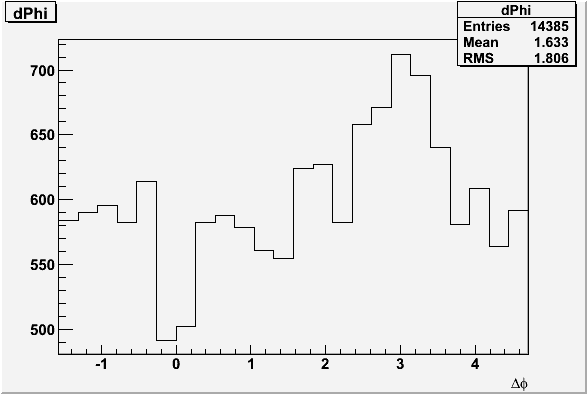 |
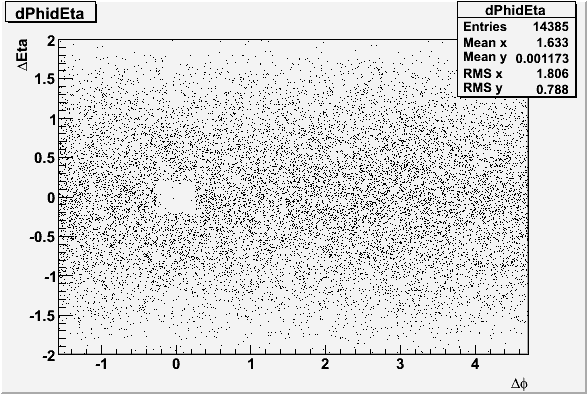 |
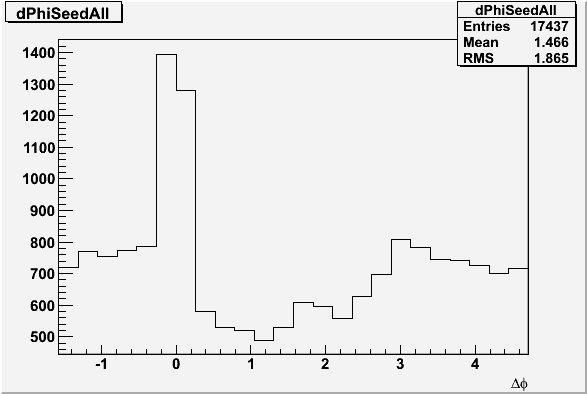 |
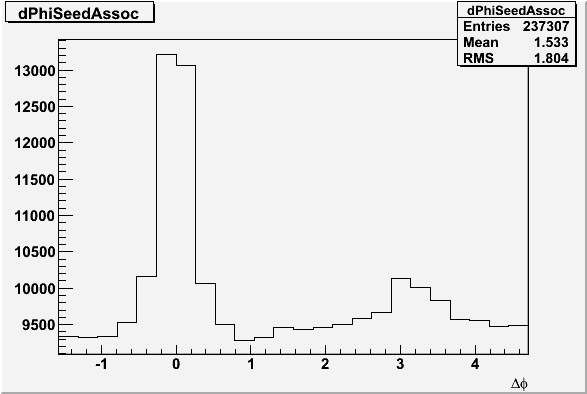 |
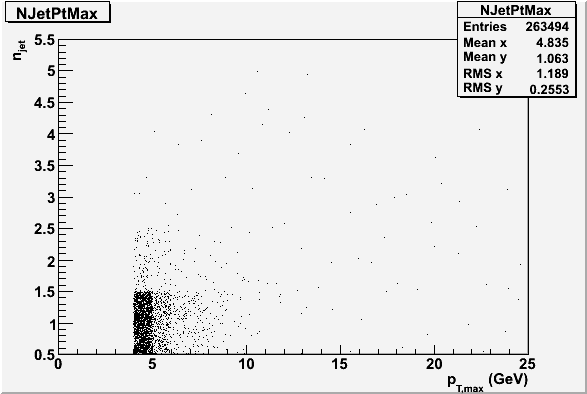 |
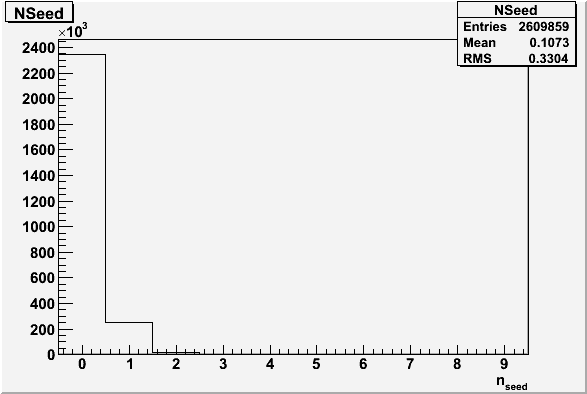 |
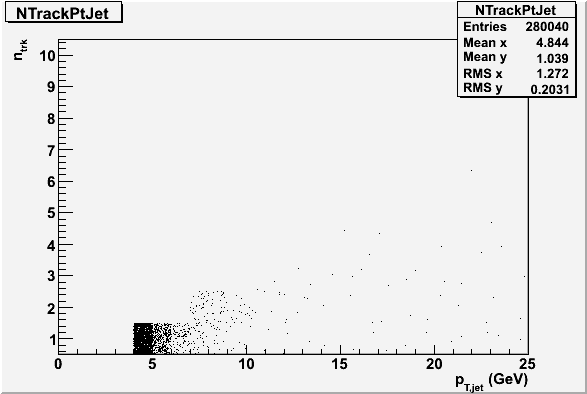 |
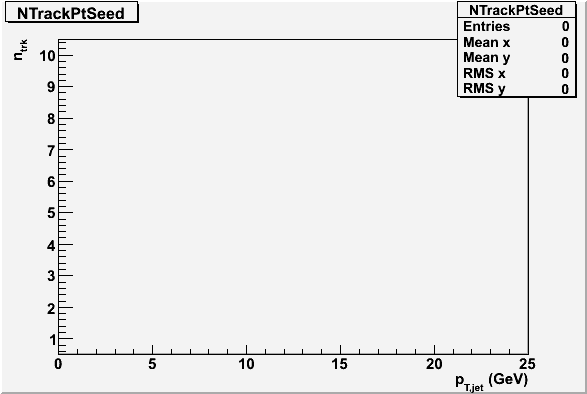 |
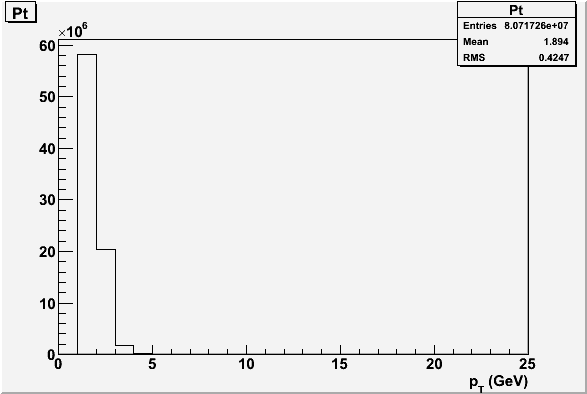 |
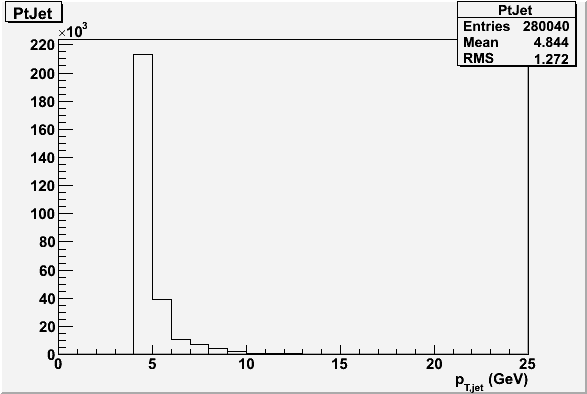 |
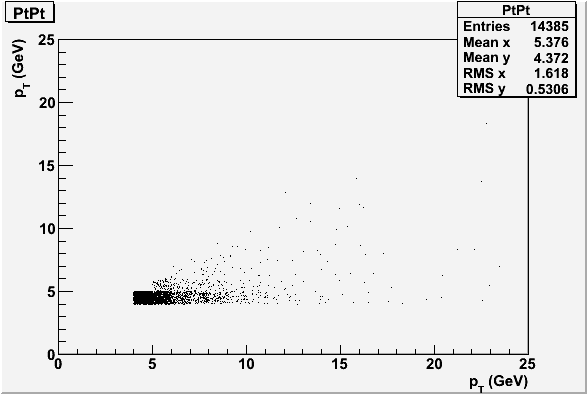 |
Sorting Out What the Code Does.
StHiJet.cxx TObjArray seedTracks;TObjArray assocTracks;
Start a loop that gathers tracks as long as the number of tracks is less than the number of tracks in the event.
for (Int_t i_tr=0; i_tr < event->NTrack(); i_tr++) {
Pick up tracks from the mDst.
StHiMicroTrack* track = (StHiMicroTrack*) event->tracks()->At(i_tr);
Make sure the number of points on the track is more than 20, the DcaGl > 1, and the pseudo rapidity meets a specified cut.
if(track->FitPts()<20)continue;
if(fabs(track->DcaGl())>1.0)continue;
if(fabs(track->EtaPr())>mEtaCut)continue;
Take the pt of the track and add it to the histogram PtPr.
mPt->Fill(track->PtPr());
If the momentum of the track is greater than the value specified for the minimum of the associated tracks add it to the array of associated tracks.
if(track->PtPr() > mMinAssoc) assocTracks.AddLast(track);
If the momentum of the track is greater than the value specified for the minimum of the seed tracks add it to the array of seed tracks.
if(track->PtPr() > mMinSeed) seedTracks.AddLast(track); }
Fill the NSeed histogram with the number of entries in the array of seed Tracks.
mNSeed->Fill(seedTracks.GetEntries());
If no seed tracks have been collected, iterate the counter and keep going.
if(seedTracks.GetEntries()==0)continue;
nevt_seed++;
Store the number of seed tracks in n_seed; ditto for the number of associated tracks in n_associated.
Int_t n_seed = seedTracks.GetEntries();
Int_t n_assoc = assocTracks.GetEntries();
Initialize parameters to zero.
pt1=0; StHiMicroTrack *Seed1=0; pt2=0; StHiMicroTrack *Seed2=0;
To keep track of the total seeds iterate n_seed_tot, the appropriate number of times matching the number of seeds taken from the event.
for (i_seed=0; i_seed < n_seed; i_seed++) { n_seed_tot++;
Put the seed track into an array(*seed_tr) which uniquely identifies it with the number i_seed. Keep track of adjacent seed tracks in the array *seed2_tr. Take the difference in the phi angles between the seed and adjacent seeds. Store the results in histogram mdPhiSeedAll.
StHiMicroTrack *seed_tr = (StHiMicroTrack *)seedTracks[i_seed]; for (Int_t i_seed2=i_seed+1; i_seed2 < n_seed; i_seed2++) { StHiMicroTrack *seed2_tr = (StHiMicroTrack *)seedTracks[i_seed2]; mdPhiSeedAll->Fill(dPhi(seed_tr->PhiPr(),seed2_tr->PhiPr())); }
Store the pt of the seed in the variable pt_jet.
pt_jet=seed_tr->PtPr(); n_trk=1;
Store the associated tracks in an array, each identified uniquely with a number i_assoc.
for (Int_t i_assoc=0; i_assoc < n_assoc; i_assoc++) { StHiMicroTrack *assoc_tr = (StHiMicroTrack *)assocTracks[i_assoc];
In addition if the seed and associated track are the same, check to see what the angle between them is and if the distance between the tracks fits into a specified cone radius add the momentum into the pt_jet variable and iterate the number of tracks.
if (assoc_tr==seed_tr) continue; mdPhiSeedAssoc->Fill(dPhi(seed_tr->PhiPr(),assoc_tr->PhiPr())); if (GetR(seed_tr,assoc_tr) < mJetR) { pt_jet += assoc_tr->PtPr(); n_trk++; } }
After collecting all the seed + associated tracks you can from all the events, fill histograms and appropriate variables.
mPtJet->Fill(pt_jet);
mNTrackPtJet->Fill(pt_jet,n_trk);
mNTrackPtSeed->Fill(seed_tr->PtPr(),n_trk);
pt_seed = seed_tr->PtPr();
phi_seed = seed_tr->PhiPr();
eta_seed = seed_tr->EtaPr();
jet_tree->Fill();
If your track momentum is still less than the jet momentum and it falls within the jet cone, store the track variables, and reassign the jet to pt1, seed1, and n_trk1. (i.e. keep the track as the jet particle.)
if (pt_jet > pt1) {
if (pt1 > 0 && GetR(seed_tr,Seed1) > mJetR) {
pt2 = pt1;
n_trk2 = n_trk1;
Seed2 = Seed1;
}
pt1 = pt_jet;
n_trk1 = n_trk;
Seed1 = seed_tr;
}
Or if the jet momentum is greater than the track momentum, and it falls outside of the cone determined by the track1, keep the current jet particle.
else if (pt_jet > pt2 && GetR(seed_tr,Seed1) > mJetR) {
pt2 = pt_jet;
n_trk2 = n_trk;
Seed2 = seed_tr;
}
Now you assume you have two tracks that you want(with p > 0) , you can store the observables appropriately.
if (pt1 > 0 && pt2 > 0) {
mPtPt->Fill(pt1,pt2);
phi1 = Seed1->PhiPr();
phi2 = Seed2->PhiPr();
eta1 = Seed1->EtaPr();
eta2 = Seed2->EtaPr();
dphi_jets = dPhi(phi1,phi2);
pair_tree->Fill();
mdPhiPtMax->Fill(dphi_jets,pt1);
mdPhiPtPt->Fill(dphi_jets,pt1,pt2);
mdPhidEta->Fill(dphi_jets, Seed2->EtaPr() - Seed1->EtaPr());
} mNJetPtMax->Fill(pt1, seedTracks.GetEntries());
} hfile->Write();
7/26/2006
email to mvl on 7/25/2006
As I'm getting things sorted out, I had a couple of quick questions7/27/2006
qsub -j y -m n -o hijet_minb_cent0.o\$JOB_ID dohijet.csh micro_list/year4_minb.lis 0
The 0 at the end refers to centrality. What is the centrality numbering scheme?
I am pretty sure it is:
0: 60-80%
1: 40-60%
2: 30-40%
3: 20-30%
5: 10-20%
6: 0-10%
7: 0-80%
Exact cuts etc are defined in StRoot/StHighptPool/StHiAnalysis/Cut.cxx (and CutRc.cxx)
Also I was wondering if all the year4 data is covered in the core_jet directory?
The himicro_low,mid,high directories contain only central triggerd events (trigid 15105) from those trgsetupnames (production Po5ic) and should be more or less complete.
The minbias directory contains only P05ia productionMinbias (ca 20M events). Since then, an additional 8 or so million events with displaced vertex were produced, and the whole thing was redone with P05ic.
No need to worry about that now, I think.
However, one thing that you should probably check is whether a trigger id cut is applied when you run over those events.
For details on trigger words and event counts, see: here
In the mean time, I also processed the d+Au datasample: /eliza2/rnc/mvl/himicro/dau for this one you also need to apply a trigger-id cut (2002 or 2003).
This is the main reference set, so it is probably good to run over this one as well to check out the stats.
Need to run over dAu as a reference, see if we have enough statistics. Need trigger word cut to separate out events with high towers. So far it looks like /home/bhaag/core_jet/StRoot/StHighptPool/StHiMicroEvent/StHiMicroEvent.h and StHiMicroEvent.cxx are the only files that mentions trigger words.
One possibly useful page here. The 2003 trigger page is here .Email from Horner regarding running over dAu:
Trigger information:(In StRoot/StHighptPool/StHiJet/StHiJet.cxx)
// check Vertex-z position
if (fabs(event->VertexZ())>30) continue;
(continue means jump back to beginning of loop)
if (event->L0TriggerWord()!=2001
&& event->L0TriggerWord()!=2003)
{
cout << "Bad trigger was : "<< event->L0TriggerWord();
continue;
}
Regular expression:
http://www.regular-expressions.info/tutorial.html
:1,$ s/^.*st_/\/eliza2\/rnc\/mvl\/himicro\/dau\/upccombined\/st_/
(regular expressions are awesome by the way)
file lists are at:
/auto/rnc3/horner/Test/{upccombined,daucombined,dauminbias}.lis
For dAu comment out the centrality check
(Also, in StRoot/StHighptPool/StHiJet/StHiJet.cxx)
/* if (cent<99)
if(getHighPtCentBin(event->Centrality())!=cent)
continue; ONLY REMOVE THIS LINE FOR DAU!!!!!!!!*/
Important note to self:
When using cons - make sure to use proper library.
For run 2 - 4 (also dAu), starver SL05c works.
To check which version you are running: env | grep STAR
running over dAu combined, not so successful!
/home/bhaag/core_jet/hijet_dau_combined.o1107125
Processing doHiJet.C("dau_micro_list/dau_combined.lis",50000000,99)...
Found 28658 files
... Last file in list : /eliza2/rnc/mvl/himicro/dau/daucombined/st_physics_4081111_raw_0030001.himicro.root requested number of events to process: 50000000
event 0
Bad trigger was:9
Bad trigger was:9
Bad trigger was:13
Bad trigger was:9
Bad trigger was:9
Bad trigger was:10
.....
seed threshold 5
assoc threshold 3.5
radius cut 0.3
tot evts: 11423522
with seeds 0, tot seeds 0
RealTime=6601.990000 seconds, CpuTime=5332.450000 seconds
You have scanned 4.132735 Mbytes/Realtime seconds
You have scanned 5.116649 Mbytes/Cputime seconds
This is the end of ROOT -- Goodbye
7/31/2006
Horner made a suggestion re: Bad Triggers.
If you want to talk to Marco's classes you have to check the actual code. But now I know how, you need to change the trigger check code to: event->IsTrigger(2001) || event->IsTrigger(2003) and then it will work properly.
8/24/2006
Next steps:
Do a comparision of &Delta &phi yields for multi and single particle triggers. Want to look at sum of seed and associated slightly above > 8 GeV
Need to generate corresponding plots of dN/d&phi which should look sort of like this:
As a first pass start with a trigger > 8 GeV, and associated particles > 2, 3, 4, 5 GeV. Need to go into the code and add the desired histograms.
9/13/2006
Had some trouble sorting out the code to produce the dN/d&phi histograms. Horner suggested the following:
lets call the histogram HistB -
You add the histogram declaration inside
void StHiJet::initHistos() {
Hist B = new TH1D("HistB","title;#Delta#phi;#frac{dN}{d(#Delta#phi)}",96,0,2*TMath::Pi());
}
but because its a class you need to declare that HistB is a pointer somewhere
- that has to go in the header file
StHiJet.h
and you should do it near the other histograms - just a line :
TH1D* HistB; // Brookie's histogram
Thats all you need to do to make sure it exists - but that was the easy part!
Now you need to fill it in the correct place (inside the loop over tracks -
because you want to work out the difference between the jet and each individual track - so you gotta do it after you found the jets)
At the beginning after teh event cuts in histofill is a loop over tracks -
the key line is the assoc.Tracks.AddLast(track) - the means this track gets
added ot the tree of interest and meets all your criteria -
the problem is that the jets haven't been found yet - so you need to use
this list a little later when you have the jets (I assume that associated here
is what I think it means?).
for (Int_t i_tr=0; i_tr < event->NTrack(); i_tr++) {
StHiMicroTrack* track = (StHiMicroTrack*) event->tracks()->At(i_tr);
if(track->FitPts()<20)continue;
if(fabs(track->DcaGl())>1.0)continue;
if(fabs(track->EtaPr())>mEtaCut)continue;
mPt->Fill(track->PtPr());
if(track->PtPr() > mMinAssoc)
assocTracks.AddLast(track);
if(track->PtPr() > mMinSeed)
seedTracks.AddLast(track);
}
later on there is this bit
for (Int_t i_assoc=0; i_assoc < n_assoc; i_assoc++) {
StHiMicroTrack *assoc_tr = (StHiMicroTrack *)assocTracks[i_assoc];
if (assoc_tr==seed_tr)
continue;
mdPhiSeedAssoc->Fill(dPhi(seed_tr->PhiPr(),assoc_tr->PhiPr()));
if (GetR(seed_tr,assoc_tr) < mJetR) {
pt_jet += assoc_tr->PtPr();
n_trk++;
}
}
and here a dn/dphi hist is filled but its teh dn/dphi between the associated
track and the seed track (not quite the jet) so you need to add this loop again
after the jets are found but with one modification - that you do the
mdPhiSeedAssoc->Fill(dPhi(seed_tr->PhiPr(),assoc_tr->PhiPr()));
as
HistB->Fill(dPhi( JETPHI ,assoc_tr->PhiPr()));
and you can drop the other junk.
I think that you can put it after this line:
mNJetPtMax->Fill(pt1, seedTracks.GetEntries());
and it should look like this:
for (Int_t i_assoc=0; i_assoc < n_assoc; i_assoc++) {
StHiMicroTrack *assoc_tr = (StHiMicroTrack *)assocTracks[i_assoc];
HistB->Fill(dPhi(phi1,assoc_tr->PhiPr())); // For jet 1
HistB->Fill(dPhi(phi1,assoc_tr->PhiPr())); // For jet 2
}
10/03/2006
Finally figured out why my histogram HistB is coming out skewed. In the code, events were getting rejected under criteria that were too strict:
"if (pt1 > 0 && pt2 > 0) {
mPtPt->Fill(pt1,pt2);
dphi_jets = dPhi(phi1,phi2);"
Both seeds are being checked for pT > 0 which isn't necessary for my histogram, but for filling the mPtPt and dphi_jets histograms.
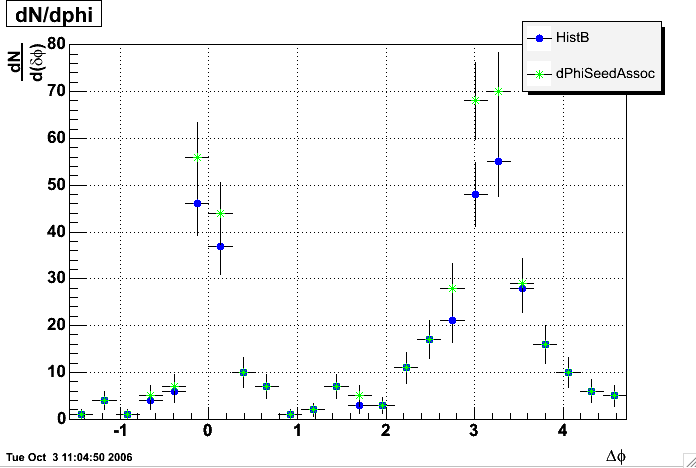 |
